 W
WAlcolapia alcalica, the common Natron tilapia or soda cichlid, is an endangered species of fish in the family Cichlidae. It is endemic to the hypersaline, warm Lake Natron, its drainage and the Shombole Swamps in Kenya and Tanzania. This species typically has an essentially terminal (straight) mouth, but a morph with an upturned mouth is found locally in eastern Lake Natron, where it co-occurs with the normal morph. A. latilabris and A. ndalalani, the two other species in Lake Natron, both have a clearly downturned mouth. Territorial males of A. alcalica have extensive blue-white spotting, and their underparts and throat can be yellow or white. Females and non-territorial males are overall sandy in colour. A. alcalica reaches up to 11.6 cm (4.6 in) in total length.
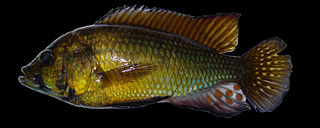 W
WAlluaud's haplo is a species of freshwater fish in the cichlid family, Cichlidae. It is native to East Africa, where it occurs in many lakes, including Lake Victoria.
 W
WAstatotilapia burtoni is a species of fish in the family Cichlidae.
 W
WAstatotilapia desfontainii is a species of cichlid found in Algeria and Tunisia. It is found in freshwater spring, irrigated land, and canals and ditches. It is threatened by habitat loss. This species reaches a length of 15 centimetres (5.9 in) TL.
 W
WAstatotilapia stappersii is a ray-finned fish species in the family Cichlidae. Adults measure about 15 cm (6 inches) in total length.
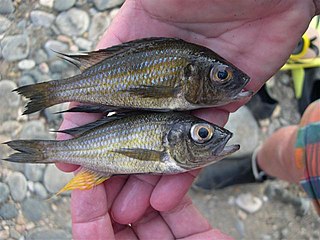 W
WAulonocranus dewindti is a species of cichlid endemic to Lake Tanganyika and some rivers which flow into it.
 W
WThe blackchin tilapia is a species of cichlid native to coastal west Africa. It is a paternal mouthbrooder which has been introduced to Asia and North America.
 W
WChromidotilapiini is a tribe of small cichlids from tropical West and Middle Africa. There are thirteen genera and over fifty described species in this tribe.
 W
WCyphotilapia gibberosa is a species of fish in the cichlid family, one of two species in the genus Cyphotilapia. Native to Lake Tanganyika in East Africa, it was described in 2003 nearly 100 years after its congener, C. frontosa. This species is a maternal mouth brooder.
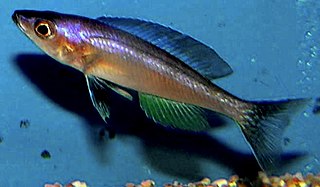 W
WCyprichromini is a tribe of African cichlids, containing seven species in two genera: Cyprichromis and Paracyprichromis. Most species are endemic to Lake Tanganyika; only C. microlepidotus has also been seen in eastern Tanzania.
 W
WDiplotaxodon macrops is a species of haplochromine cichlid which is endemic to Lake Malawi. It is found throughout the lake in Malawi, Mozambique, and Tanzania. Within Lake Malawi it is abundant near the lake bed over rock shelves. It appears to be a plankton eating species that feeds on insect larvae, crustaceans, and diatoms.
 W
WDocimodus johnstoni is a species of haplochromine cichlid. It is known from Lake Malawi, Lake Malombe, and the upper Shire River in Malawi, Mozambique, and Tanzania. This species has unusual feeding habits: it is reported to feed on fins of clariid catfishes. The specific name honours the British explorer, botanist, linguist and Colonial administrator, Sir Henry Hamilton Johnston, who presented the type to the British Museum.
 W
WEctodini is a tribe of cichlids that are endemic to Lake Tanganyika in East Africa. They live in the benthic zone. Most of the genera in this tribe are monotypic. These fishes show diverse morphology and behaviour and the tribe includes taxa which live in sandy, muddy and rocky habitats.
 W
WEctodus descampsii is a species of cichlid fish endemic to Lake Tanganyika in East Africa where it prefers areas with substrates of coarse sand. It feeds on micro-organisms, algae and diatoms. This species reaches a length of 10.4 centimetres (4.1 in) TL. It is also found in the aquarium trade. It is currently the only known member of its genus. The specific name honours Capitaine Georges Descamps (1855-1938), a Belgian officer in the anti-slavery movement at Lake Tanganyika.
 W
WEretmodini is a tribe of African cichlids. It contains five species of freshwater fish endemic to Lake Tanganyika. They are small fish with reduced swim bladders that are found near the bottom in the turbulent, coastal surf zone. They are mouthbrooders.
 W
WThe haplochromine cichlids are a tribe of cichlids in subfamily Pseudocrenilabrinae called Haplochromini. This group includes the type genus (Haplochromis) plus a number of closely related genera such as Aulonocara, Astatotilapia, and Chilotilapia. They are endemic to eastern, southern and northern Africa, except for Astatotilapia flaviijosephi in the Middle East. A common name in a scientific context is East African cichlids – while they are not restricted to that region, they are the dominant Cichlidae there. This tribe was extensively studied by Ethelwynn Trewavas, who made major reviews in 1935 and 1989, at the beginning and at the end of her career in ichthyology. Even today, numerous new species are being described each year.
 W
WHemichromini is a tribe of African cichlids. The group consists of 14 species of freshwater fish from two genera: one species in Anomalochromis and the remaining in Hemichromis.
 W
WJulidochromis dickfeldi is a species of cichlid endemic to Lake Tanganyika in Africa where it is only known from the southwestern portion. This species inhabits areas with rock/rubble substrates, each fish maintaining a territory around a crevice or crack. This species reaches a length of 11 centimetres (4.3 in) TL. The specific name honours the German fishkeeper Alf Dickfeld who proposed the expedition on which the type was collected.
 W
WThe konye (Konia eisentrauti) is a critically endangered species of fish in the family Cichlidae. It is endemic to Lake Barombi Mbo, a crater lake in western Cameroon. It is threatened because of pollution and sedimentation due to human activities, and potentially also by large emissions of carbon dioxide (CO2) from the lake's bottom (compare Lake Nyos). This species can reach a length of 9.3 centimetres (3.7 in) TL.
 W
WLimnochromini is a tribe of African cichlids from Lake Tanganyika. They are bi-parental and mouthbrooding fish.
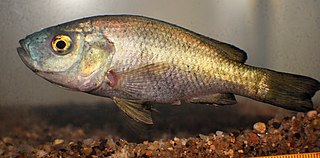 W
WThe myaka (Myaka myaka) is a critically endangered species of cichlid endemic to Lake Barombi Mbo in western Cameroon. It prefers open, deeper waters where it feeds on phytoplankton and small insects, only venturing into shallower waters to spawn. This species can reach a length of 6.7 centimetres (2.6 in) SL. It is currently the only known species in its genus, but it is very close to Sarotherodon. The myika is threatened because of pollution and sedimentation due to human activities. It is potentially also threatened by large emissions of carbon dioxide (CO2) from the lake's bottom (compare Lake Nyos), although studies indicate that Barombo Mbo lacks excess amounts of this gas. Konia, Pungu and Stomatepia are three other equally threatened genera of ciclids that also are endemic to Lake Barombi Mbo.
 W
WThe nsess (Stomatepia mariae) is a species of cichlid endemic to Lake Barombi Mbo in western Cameroon. It can also be found in the aquarium trade. It is critically endangered because of pollution and sedimentation due to human activities. It is potentially also threatened by large emissions of carbon dioxide (CO2) from the lake's bottom (compare Lake Nyos), although studies indicate that Barombo Mbo lacks excess amounts of this gas.
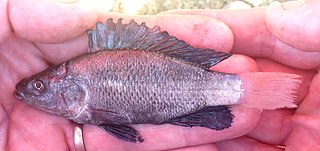 W
WOreochromis amphimelas is a species of tilapia cichlid endemic to north–central Tanzania, where it is found in Lake Manyara and a number of other saline lakes with closed basins. Maximum recorded size is 28 cm (11 in) in standard length.
 W
WParatilapia is a genus of cichlids generally restricted to Madagascar. These are large, dark cichlids densely covered in light spots. An additional very poorly known species from the Congo River basin in mainland Africa is sometimes also placed in the genus, but this is highly questionable and arguably it is better placed in the "wastebasket genus" Haplochromis for the time being.
 W
WParatilapia is a genus of cichlids generally restricted to Madagascar. These are large, dark cichlids densely covered in light spots. An additional very poorly known species from the Congo River basin in mainland Africa is sometimes also placed in the genus, but this is highly questionable and arguably it is better placed in the "wastebasket genus" Haplochromis for the time being.
 W
WParetroplus is a genus of fishes in the cichlid family, all of which are endemic to lakes and rivers of Madagascar. The vast majority are threatened and restricted to the northwestern part of the island. Only P. polyactis is found in the southern half of Madagascar and only P. polyactis and P. gymnopreopercularis are found in eastern drainages. Most are restricted to freshwater, but at least P. polyactis and P. maromandia can also be seen in brackish habitats.
 W
WThe Pearl of Likoma is a species of fish in the family Cichlidae endemic to Lake Malawi where it is native to rocky areas around Likoma Island and it has been introduced to Thumbi West Island. This species can reach a length of 10 centimetres (3.9 in) TL. It can also be found in the aquarium trade. Males are blue, while females are a greenish blue with rows of yellowish spots and shiny gills. They feed on crustaceans, insects, and larvae.
 W
WThe pindu is a critically endangered species of cichlid endemic to Lake Barombi Mbo in western Cameroon.
 W
WThe Ptychochrominae are a subfamily in the cichlid family of fish. It includes about 14 species. They are restricted to lakes and rivers in Madagascar, and the majority are threatened. Most cichlid genera native to Madagascar are included in this subfamily; the only exceptions are Paretroplus and Paratilapia.
 W
WThe pungu is a species of cichlid endemic to Lake Barombi Mbo in Cameroon where it prefers shallow waters of about 1 to 3 metres in depth. It feeds on invertebrates, sponges, diatoms and macrophytes. This species can reach a length of 10 centimetres (3.9 in) SL. It is currently the only known member of its genus, but it is very close to Sarotherodon. The pungu is threatened because of pollution and sedimentation from human activities. Konia, Myaka and Stomatepia are three other equally threatened genera of cichlids that also are endemic to Lake Barombi Mbo. The specific name of this fish honours the Fisheries Development Officer of Nigeria, P.I.R. MacLaren, who used his position to collect specimens of fishes, including the type of this species.
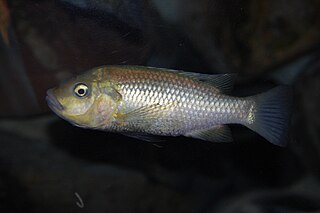 W
WSarotherodon linnellii, sometimes known as the unga, blackfin tilapia or blackbelly tilapia, is a cichlid endemic to Lake Barombi Mbo in western Cameroon. This species reaches a length of 18.5 centimetres (7.3 in) SL. It is critically endangered because of pollution and sedimentation due to human activities. It is potentially also threatened by large emissions of carbon dioxide (CO2) from the lake's bottom (compare Lake Nyos), although studies indicate that Barombo Mbo lacks excess amounts of this gas.
 W
WStomatepia is a genus of cichlids endemic to Lake Barombi Mbo in western Cameroon. Although generally recognized as distinct, the genus is very close to Sarotherodon. The Stomatepia species are all recognized as critically endangered by the IUCN because of pollution and sedimentation due to human activities. They are potentially also threatened by large emissions of carbon dioxide (CO2) from the lake's bottom (compare Lake Nyos), although studies indicate that Barombo Mbo lacks excess amounts of this gas. Konia, Myaka and Pungu are three other equally threatened genera of ciclids that also are endemic to Lake Barombi Mbo.
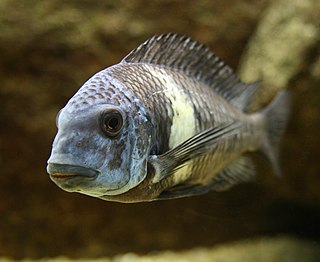 W
WTropheini is a tribe of African cichlids, endemic to Lake Tanganyika. The species in this tribe are mouthbrooders.
 W
WTropheops tropheops is a species of cichlid endemic to Lake Malawi preferring areas with rocky substrates. This species can reach a length of 14 centimetres (5.5 in) TL. It can also be found in the aquarium trade.
 W
WTylochromis is a genus of African fishes in the family Cichlidae. They are the only members of the tribe Tylochromini. Many of the species are endemic to the Congo River Basin, but species also are found in Lake Tanganyika, Cameroon, Nigeria, and West Africa from Ghana to Gambia.
 W
WUtaka is the term used for open water-dwelling cichlids found in Lake Malawi, the most diverse source of cichlids in the world of amateur aquaria. Among others, they comprise all the members of the genera Copadichromis and Mchenga.
 W
WXenotilapia is a genus of cichlids species endemic to Lake Tanganyika in east Africa.